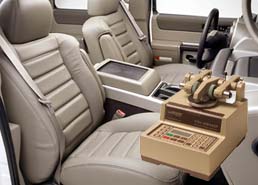Leather Upholstery

Situation:
Historically, tests to evaluate the abrasion resistance of leather followed a variation of ASTM D3884 – abrade specimens with CS-10 wheels for 1,000 cycles using a 1,000-gram load. However, ASTM D3884 is a test method for textiles and difficulties arose after Taber released the improved CS-10 wheels.
During the “Taber test” specimens are abraded using the rotary rubbing action of two wheels under controlled conditions of pressure and abrasive action. As the wheels abrade the specimen surface, debris is generated and removed by the vacuum system. Many leathers are produced with protective topcoat such that, as it is abraded, debris adhered to the wheel surface instead of being removed. After the improved CS-10 wheels were released, this debris no longer adhered or “coated” the wheels resulting in a significant decrease in test cycles (and hence, abrasion resistance) for many leathers.
During our efforts to address leather customer concerns, Taber realized that specific details were missing in the test procedures and recognized this as an opportunity to develop a new test method specific to the abrasion resistance of leather.
Analysis:
As a starting point, Taber solicited input from leather producers and users. After confirming there was ample interest in the development of a new procedure, ASTM’s D31 committee for Leather was approached to assist with the process. Then Taber began the task of reviewing the current methods to identify any ambiguities.
As leather is a natural product, our first observation was that physical properties may vary depending on location on the hide, side or skin from which the test sample is taken. Unfortunately there were no instructions on how to minimize this when preparing samples.
Regarding the test procedure, little to no information defining vacuum force and vacuum height was provided. Based on prior experience, Taber knew that when the vacuum nozzle height is set too high above the specimen, debris was not adequately removed. Conversely, when the vacuum nozzle is set too close to the specimen, ample airflow may not be permitted which could result in an overheated condition of the vacuum motor. But more importantly, the vacuum suction might be too concentrated to lift the loose grit particles and abradings from the entire wear path. Another problem that might occur is the suction could lift the specimen during the test so that contact is made with the vacuum nozzle, causing additional wear.
Another ambiguity that was identified was the method of specimen mounting. Is the clamp plate and nut sufficient, or should the clamp hold-down ring also be used? Textile customers were not utilizing mounting cards because it would interfere with identifying yarn breaks, but this was not a concern for leather customers and many found the mounting cards to be extremely convenient!
Perhaps the greatest ambiguity centered on the determination of the end-point. In ASTM D3884, abraded textiles are evaluated by either Residual Breaking Load; Percent Loss in Breaking Load; or Cycles Required to Give Specified Destruction. The practice that was in place for leather was to either to test to a minimum number of cycles or run to “failure”. Unfortunately there was little instruction provided to define exactly what a failure was. Variation in judging a specimen’s condition may occur as the instrument operator makes a subjective evaluation. With an experienced operator this may not pose much concern, but it certainly raised a question of reproducible test results from different locations.
Benefit:
In 2006, ASTM D7255 Standard Test Method for Abrasion Resistance of Leather (Rotary Platform, Double-Head Method) was published. This method has addressed each of the shortcomings listed above and will improve the reliability of the Taber test for leather. Although many automotive OEM’s continue to use their own procedures, updating references from ASTM D3884 to ASTM D7255 will clarify the intended test procedure and eliminate much of the variation that might be introduced with the test set-up.


